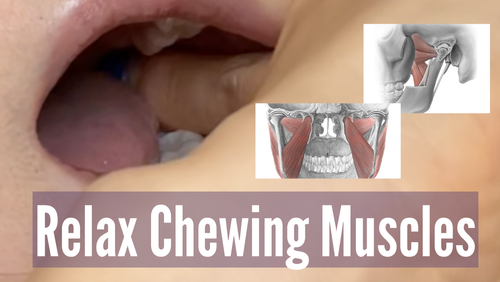Today I'm going to talk about how to relax your chewing muscles. When these muscles are so tight, you're going to get more headaches, more grinding and a grinding condition (AKA a square face). If we want to prevent those symptoms from happening again in the future, we need to learn how to relax these muscles.
So let me introduce you to the four fortunate muscles and how you can relax them in order to prevent those headaches and other problems like a square face or a saggy face or even TMJ pain. If you have that clicking sound in your jaw, be sure to do the exercises with me together today, because these techniques are not really about face posture they're more like a buccal massage technique. Let's do it!
1. Masseter Muscle
The muscles of our face are like a muscle group: they're all connected to each other, and they all have to work together. When one is overused, it can cause problems for others. That's why we want to keep them healthy by massaging them every day.
To do so, wash your hands first, then put your finger on the muscle that you want to massage. Then relax your mouth and close it gently—just enough so the muscle doesn't get stretched out or overworked. Then just gently massage that area until you feel good! This is something that's important to do every day, so be sure not to forget about it!
2. Temporalis Muscle
The temple temporalis muscle is one of the muscles that can cause tension headaches. It's important to know how to relax this muscle because if it gets too tense, it can cause headaches.
You can do this by using your fingers to massage it gently. You can do circles or zigzags with your fingers or you can use a finger hook and move the skin back and forth in small movements. Whatever you prefer! Just make sure that it's gentle and not painful.
If you want to be lazy, you can just put your elbow on the table and then move your head instead of moving your fingers—this way you won't get tired as easily!
3. Lateral Wing Rib
The lateral wing is a muscle in the jaw that helps you open your mouth and drop your jaw. It's also used to slide out and in.
It's important to find this muscle because it's not always easy to see, and it can be hard to feel without practice.
To find the lateral wing, put your fingers above your upper teeth, then slide them forward (away from the teeth) until you feel a stretch in the wisdom teeth area. You'll be able to feel the muscle stretching every time you open your mouth!
4. Medial Pterygoid Muscle
The medial pterygoid muscle is another one of the muscles that we use every single day. It's actually inside of this yellow muscle here, and I put it here to make it easier to see. This little yellow muscle is the medial pterygoid muscle. It's bigger and longer, and its purpose is to close your mouth. So when you're chewing with your mouth closed, you're using this muscle.
It's also called the sliding muscle because when we eat, we don't just do this (shows eating motion). We do something like this (showing a slight sliding motion). That's why we use the medial pterygoid muscle when we chew—to help us swallow our food!
Now let's figure out where it is! Put your finger inside your mouth and find this ball-like mandible bone on one side of your jawbone. Find this pillar and catch it; then it's inside but outside at first. Now all five of us together will open our mouths a little bit so we feel more movement from our medial pterygoid muscles contracting while we chew! You can feel them contracting slightly when you chew!
Let me summarize the four chewing muscles to relax. The first one is the masseter muscle. Next is the temporalis muscle, which is my favorite because you can use it while sitting at a table and only have to move your elbow up and down (or side to side), so you don't have to tire your hand out. The third one is the lateral wing rib—the side one, which follows the aftertaste. And finally, the fourth one is the medial pterygoid muscle, which is really deep inside your mouth.
It's important to relax these muscles regularly so that they don't get tight and cause pain in your jaw or face! So here's how you do it: put your elbow on the table and then move your head like this or like this so that you don't have to tire your hand out. If that's too easy or lazy for you, try moving both hands at once by holding them together like this and then stretching them out in front of you as far as possible—but be careful not to strain yourself!

